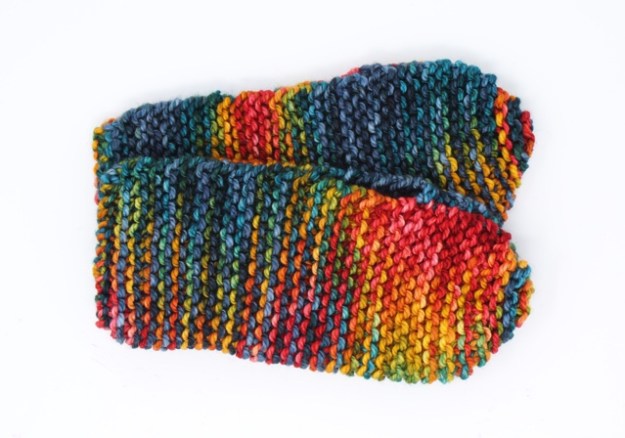
Granny Slippers
A client came in last night who wanted to make some granny slippers, and it occurred to me that I’ve NEVER made a pair, and maybe I should step outside my box and try a pair. I’m happy to report that they were SUPER EASY, beginner friendly (like after scarves), fast, and don’t use a ton of yarn, and are super cosy and warm! I whipped up a pair in one evening, so they’re definitely doable for holiday gifts. They aren’t fancy, but they are definitely cosy, warm, and fast!
I decided I wanted a funkier pair and used one skein of hand dyed Fleece Artist Back Country, but another great (less pricey) yarn would be Berroco Vintage Chunky. The yarn was lovely (as always), soft and smooth. If you want a pair of fuzzy slippers you could hold together 1 strand of Cascade 220 Superwash and 1 strand of Drops Brushed Alpaca and Silk (1 ball of each should be enough. The pattern, Easy Steps by Drops, is a freebie, and was fairly easy to follow. Please read below for our modifications and notes.

Modifications & Pattern Notes
A. I used 5mm/US8 needles, and it made the tension a bit tighter, 15 sts = 4″ (10cm). My feet are narrow, so this didn’t make a big difference in size, but if you are knitting for wider feet I would add a couple of stitches to the pattern.
B. The pattern, which was not originally written in english, has one phrase that novices might find confusing. It says “K sts tog 2 by 2”. What they want you to do is K2tog across the row (so knit 2 stitches together, and keep doing this to the end of the row. For beginners, the pattern website also has a how-to video on how to knit 2 stitches together.
C. For beginners who do not know how to seam (or for more experienced knitters who may not know how to do this particular seaming prettily), the pattern website offers some handy how-to videos to get you through the project. To make a tidy seam at the back of the foot (because it is a cast-on edge) this may be a helpful video.
D. Please see our Hack below for suggestions on making sure the colour distribution of hand painted, variegated yarns is the same for both your slippers! If you’re using a solid, heathered or semi-solid yarn you don’t need to worry about this, but you might find it interesting and useful information for the future.
Materials
- Fleece Artist Back Country (colour: Masala) or Berroco Vintage Chunky: 1 skein
- 5.5mm/US9 (or 5mm/US8 for a tighter tension) needles (straight or circular)
- tapestry needle
- FREE Pattern

Knit Hack
And now for the hack! It’s a universal knitting truth that variegated yarns have a tendency for the colours to pool in ways we can’t anticipate. Sometimes it’s fun, funky, and enhances the project, and sometimes we don’t really care for it. It’s random, it happens, and we learn to accept it. You can usually play around with this effect by varying the needle size, the number of stitches you put on, and the stitch pattern you choose. But while knitting these slippers I found out something new – the place in the colourway that you cast on (where you place your slip knot or first stitch), can have an effect.
Option A) Asymmetrical Pooling Approximately half of the colourway in this particular skein is dark, and the other half was colourful (lets say it starts with the dark blue, the moves into a second part, the brighter warm colours). In the picture above, I made the slip knot around where the colour is changing between the two. The colours pooled kind of randomly, and I thought it worked with the skippers once they were seamed – they’re kinda funky.

Option B) Symmetrical Pooling In this picture, I made the slip knot around the centre of the dark part of the colourway (so about 1/4 of the way through the colour repeat). The colours ended up pooling completely symmetrically! All the Blues stacked up on the right and the reds lined up on the left. It was super cool. It also didn’t suit my sensibilities for this project, although I kind of want to make a neckwarmer this way.
Caveat Emptor: every skein of hand-dyed yarn is different, so this isn’t a rule. so much as a factor. Like I said at the start, the number of stitches, the tension and the stitch pattern also have an effect on the colour distribution. But if you are making your own slippers with hand-dyed, variegated yarn, be sure to cast on in the same place in the colourway to get a similar colour distribution.
So there you go, you learn something new every day! For more information on colour distribution in variegated yarns, I highly recommend the book Artful Color, Mindful Knits.

